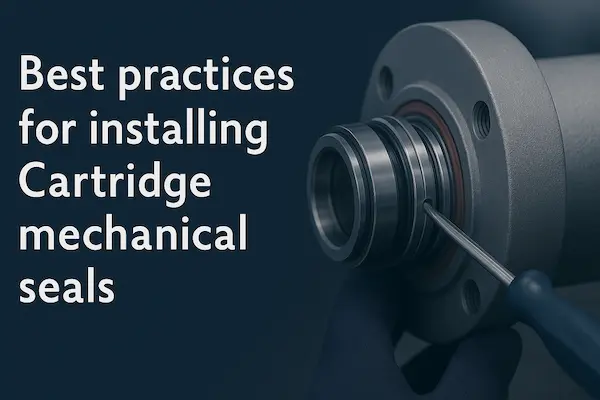Posted At: Sep 26, 2025 - 331 Views

Best Practices for Installing Cartridge Mechanical Seals
Introduction
Cartridge mechanical seals are one of the most reliable sealing solutions for pumps and rotating equipment. Unlike traditional component seals, cartridge seals are pre-assembled, making them easier to install while reducing the risk of human error. However, even though they are user-friendly, improper installation can still lead to premature failures, leakage, or costly downtime.
In this guide, we’ll walk through the best practices for cartridge mechanical seal installation, along with common mistakes to avoid, maintenance tips, and answers to frequently asked questions.
Understanding Cartridge Mechanical Seals
Before moving into installation, it’s important to understand what makes cartridge seals different.
Pre-assembled unit: Cartridge seals come as a complete assembly, including gland, sleeve, O-rings, and setting clips.
Easy installation: No need for precise measurements of spring compression as required in component seals. To learn more about mechanical seal installation, please check here.
Safer and reliable: They reduce the risk of incorrect fitting, misalignment, and leakage.
This makes cartridge seals the preferred choice in industries such as oil & gas, chemical processing, water treatment, and power generation.
Pre-Installation Checks
Before starting the cartridge mechanical seal installation, follow these checks:
Inspect the Shaft and Equipment
Ensure the pump shaft is free from wear, burrs, or damage.
Clean the shaft thoroughly to remove dirt, rust, or old seal remnants.
Verify Seal Compatibility
Match the cartridge seal type with the pump model.
Confirm size, temperature, and pressure ratings.
Check Lubrication & Cooling System
Ensure proper lubrication channels are clean.
Confirm that the cooling water system is functional.
Workplace Cleanliness
Always install seals in a clean environment.
Dust and debris can damage sealing faces.
Step-by-Step Best Practices for Installing Cartridge Mechanical Seals
Follow these cartridge seal installation guidelines to achieve leak-free performance:
Read the Manufacturer’s Instructions
Every seal type may have slight variations. Always check the manual.
Prepare the Shaft
Apply a thin film of clean lubricant to the shaft for smooth installation.
Position the Seal Cartridge
Slide the cartridge seal carefully onto the shaft.
Avoid applying force or striking the seal faces.
Align the Seal Properly
Ensure the gland is positioned squarely against the pump housing.
Tighten Bolts Evenly
Tighten the gland bolts diagonally in sequence to avoid misalignment.
Remove Setting Clips
Once the seal is secured, remove all setting clips before running the pump.
Double-Check O-rings & Secondary Seals
Make sure O-rings are seated properly to avoid leakage.
Common Mistakes to Avoid
Even with cartridge seals, small mistakes can lead to big issues. Avoid the following:
Installing without cleaning the pump shaft.
Over-tightening gland bolts.
Running the pump dry before proper lubrication.
Forgetting to remove setting clips.
Ignoring signs of equipment wear.
Post-Installation Checks
After installing a cartridge seal:
Perform a Pressure Test: Confirm no leakage under test pressure.
Run a Dry Rotation Check: Ensure smooth shaft rotation.
Monitor Initial Operation: Watch for unusual noise, vibration, or heat build-up.
Maintenance Tips for Longer Seal Life
To maximize seal performance, follow these mechanical seal maintenance best practices:
Regularly check for leaks or abnormal wear.
Ensure continuous lubrication and cooling supply.
Avoid running pumps dry.
Schedule periodic maintenance to inspect seals and replace when necessary.
Conclusion
Proper cartridge mechanical seal installation ensures long-lasting performance, reduced downtime, and leak-free operation. By following best practices—such as cleaning the shaft, aligning correctly, and tightening bolts evenly—you can prevent common failures and maximize efficiency.
At QMSeals, we provide high-quality cartridge mechanical seals designed for demanding industrial applications. Contact us today to find the right sealing solution for your pumps.
Frequently Asked Questions
How do you install a cartridge mechanical seal?
To install a cartridge mechanical seal, clean the shaft, slide the seal into place, align the gland, tighten bolts evenly, and remove the setting clips before starting the pump.
What are the advantages of cartridge seals over component seals?
Cartridge seals are pre-assembled, easy to install, reduce errors, and provide higher reliability compared to component seals.
What is the most common mistake in mechanical seal installation?
The most common mistake is failing to clean the shaft properly or forgetting to remove the setting clips before startup.
How can I extend the life of my cartridge seal?
Regular maintenance, proper lubrication, and following manufacturer guidelines will help extend the seal’s life.


